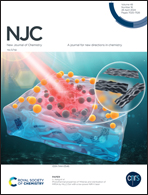Carbon dots analysis of charge transfer intrinsic capacity based on the analytic calculation of chemical reactivity descriptors†
Abstract
In this study, we focus on the theoretical calculation of global and local chemical reactivity descriptors for chiral carbon dots derived from pyrene and amino acids through ADPT (auxiliary density perturbation theory) linear response implemented in deMon2k software. We assessed the presence of hydroxyl, hydrosulfide groups, and nitrogen heteroatoms in the graphitic system of carbon dots. After optimizing the geometries, global chemical reactivity descriptors were computed using both traditional and analytical approaches. It has been observed that the presence of nitrogen heteroatoms increases the overall nucleophilic character of CDs, reduces the HOMO–LUMO gap and generates more nucleophilic and electrophilic reactive sites throughout the aromatic system. The position of nitrogen atoms was found to influence the planarity of the graphitic system, potentially compromising properties related to intramolecular electron transfer. Thiol groups at the edges of the CDs were identified to enhance the nucleophilic character of the pyrene fragment, exhibiting a more positive charge compared to the oxygen of the alcohol group. Amino acid fragments exhibit stereoselective reactivity, however, in the model systems examined here, their reactivity is surpassed by the pyrene fragment, which is highly reactive due to its planar conjugate system. These findings could contribute significantly to the structural design and understanding of properties for carbon dots developed for various technological applications.



 Please wait while we load your content...
Please wait while we load your content...